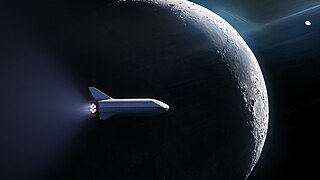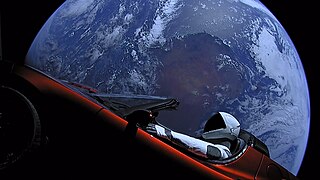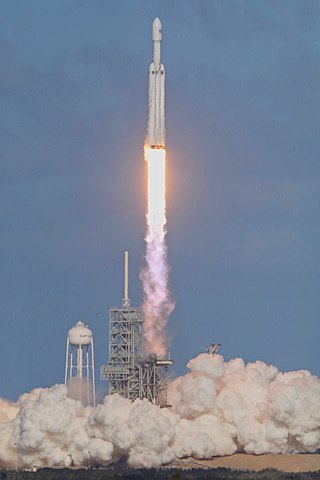Related Research Articles
A knowledge ark is a collection of knowledge preserved in such a way that future generations would have access to said knowledge if all other copies of it were lost.

Tesla, Inc. is an American multinational automotive and clean energy company headquartered in Austin, Texas, which designs, manufactures and sells electric vehicles, stationary battery energy storage devices from home to grid-scale, solar panels and solar shingles, and related products and services.

Nova Spivack is an American entrepreneur, venture capitalist, and author. He is the founder and CEO of the early stage science and technology incubator Magical and co-founder of The Arch Mission Foundation.

Falcon Heavy is a partially reusable super heavy-lift launch vehicle that can carry cargo into Earth orbit, and beyond. It is designed, manufactured and launched by American aerospace company SpaceX.

SpaceIL is an Israeli organization, established in 2011, that competed in the Google Lunar X Prize (GLXP) contest to land a spacecraft on the Moon.

Tesla Energy Operations, Inc. is the clean energy division of Tesla, Inc. that develops, manufactures, sells and installs photovoltaic solar energy generation systems, battery energy storage products and other related products and services to residential, commercial and industrial customers.

Lunar tourism may be possible in the future if trips to the Moon are made available to a private audience. Some space tourism startup companies are planning to offer tourism on or around the Moon, and estimate this to be possible sometime between 2023 and 2043.

A super heavy-lift launch vehicle is a rocket that can lift to low Earth orbit a "super heavy payload", which is defined as more than 50 metric tons (110,000 lb) by the United States and as more than 100 metric tons (220,000 lb) by Russia. It is the most capable launch vehicle classification by mass to orbit, exceeding that of the heavy-lift launch vehicle classification.

The billionaire space race is the rivalry among entrepreneurs who have entered the space industry from other industries - particularly computing. This private spaceflight race involves sending privately developed rockets and vehicles to various destinations in space, often in response to government programs or to develop the space tourism sector.

The dearMoonproject is a lunar tourism mission and art project conceived and financed by Japanese billionaire Yusaku Maezawa. It will make use of a SpaceX Starship spacecraft on a private spaceflight flying a single circumlunar trajectory around the Moon. The passengers will be Maezawa and eight other civilians, and there may be one or two crew members. The project was unveiled in September 2018 and was scheduled to launch in 2023. It has since been indefinitely delayed until Starship completes development. The project objective is to have eight passengers travel with Maezawa for free around the Moon on a six-day tour. Maezawa said that they expect the experience of space tourism to inspire the accompanying passengers in the creation of something new. If successful, the art would be exhibited some time after returning to Earth with the goal of promoting peace around the world.

Elon Musk's Tesla Roadster is an electric sports car that served as the dummy payload for the February 2018 Falcon Heavy test flight and became an artificial satellite of the Sun. A mannequin in a spacesuit, dubbed "Starman", occupies the driver's seat. The car and rocket are products of Tesla and SpaceX, respectively, both companies headed by Elon Musk. The 2010 Roadster is personally owned by and previously used by Musk for commuting to work. It is the first production car launched into space.

The Falcon Heavy test flight was the first attempt by SpaceX to launch a Falcon Heavy rocket on February 6, 2018, at 20:45 UTC. The successful test introduced the Falcon Heavy as the most powerful rocket in operation at the time, producing five million pounds-force (22 MN) of thrust and having more than twice the payload capacity of the next most powerful rocket, United Launch Alliance's Delta IV Heavy.

Starship is an American two-stage super heavy lift launch vehicle under development by aerospace company SpaceX. It is the largest and most powerful rocket ever flown. Starship is intended to be fully reusable, allowing both stages to be recovered after a mission and to be rapidly reused.

Beresheet was a demonstrator of a small robotic lunar lander and lunar probe operated by SpaceIL and Israel Aerospace Industries. Its aims included inspiring youth and promoting careers in science, technology, engineering, and mathematics (STEM), and landing its magnetometer, time capsule, and laser retroreflector on the Moon. The lander's gyroscopes failed on 11 April 2019 causing the main engine to shut off, which resulted in the lander crashing on the Moon. Its final resting position is 32.5956°N, 19.3496°E.
This article is a summary of the 2020s in science and technology.

Starship HLS is a lunar lander variant of the Starship spacecraft that is slated to transfer astronauts from a lunar orbit to the surface of the Moon and back. It is being designed and built by SpaceX under the Human Landing System contract to NASA as a critical element of NASA's Artemis program to land a crew on the Moon.

On April 11, 2019, the Israeli spacecraft Beresheet crashed into the Moon during a failed landing attempt. Its payload included a few thousand tardigrades. Initial reports suggested they could have survived the crash landing. If any of them did survive, they would be the fourth animal species to reach the surface of the Moon, after humans, brought by the American Apollo program, and fruit flies and silkworms, the latter 2 both brought to the moon by China's Chang'e 4.
We believe the chances of survival for the tardigrades... are extremely high.
References
- ↑ Nova Spivack. "Let's Put the Wikipedia in Space: The Arch Project". Archived from the original on May 27, 2020. Retrieved February 25, 2020.
- ↑ "About Our Mission". Arch Mission. Archived from the original on April 14, 2018. Retrieved April 13, 2018.
- ↑ Shields, Jesslyn (March 8, 2019). "The Lunar Library: A Backup of Human Knowledge Is Going to the Moon". HowStuffWorks. Retrieved March 28, 2021.
- ↑ May, Patrick (February 7, 2018). "Elon Musk Sent Up Something Else Unusual in That Rocket Besides a Tesla". Mercury News. Archived from the original on April 14, 2018. Retrieved April 13, 2018.
- ↑ Robitzski, Dan (February 25, 2019). "Israeli Moon Lander Is Carrying a Vast Backup of Human Knowledge". Futurism. Retrieved March 28, 2021.
- ↑ Clemens, Danny (February 10, 2018). "The SpaceX launch included a small library that could orbit the Sun for millions of years". ABC 30 Action News. Archived from the original on February 14, 2018. Retrieved February 14, 2018.
- ↑ Berman, Robby (February 13, 2018). "Hidden on the Falcon Heavy were the first books for a space library". Big Think. Archived from the original on February 15, 2018. Retrieved February 14, 2018.
- 1 2 Morris, David Z. (February 10, 2018). "Elon Musk Sent This Classic Sci-Fi Novel Into Space on the Falcon Heavy". Fortune. Archived from the original on April 14, 2018. Retrieved April 13, 2018.
- 1 2 3 4 5 6 7 Rafi Letzter (February 9, 2018). "The Most Interesting Thing Shot into Space This Week Wasn't a Tesla". Live Science. Archived from the original on March 16, 2018. Retrieved March 15, 2018.
- ↑ "Arch Library Created Using 5D Optical Storage Technology". Storage Newsletter. February 14, 2018. Archived from the original on April 14, 2018. Retrieved April 13, 2018.
- ↑ "Optical 'Superman' memory flies with orbiting Tesla". Optics. February 7, 2018. Archived from the original on February 7, 2018. Retrieved February 17, 2018.
- 1 2 Peter Dockrill (February 12, 2018). "SpaceX Hid a Second, Secret Payload Aboard Falcon Heavy, And It Sounds Amazing". Science Alert. Archived from the original on February 17, 2018. Retrieved March 15, 2018.
- 1 2 Chris Taylor (February 9, 2018). "Forget the Tesla, Elon Musk launched the first books in an ever-lasting space library". Mashable. Archived from the original on February 18, 2018. Retrieved February 17, 2018.
- ↑ Olson, Eric (February 14, 2018). "Backing Up Humanity: First Arch Launched on Falcon Heavy". Engineering360. Archived from the original on February 15, 2018. Retrieved February 14, 2018.
- ↑ Gohd, Chelsea (February 12, 2018). "Everything You Need to Know about SpaceX's Secret Falcon Heavy Payload". Futurism. Archived from the original on April 14, 2018. Retrieved April 13, 2018.
- ↑ Pearlman, Robert Z. (February 7, 2018). "'A Car in Deep Space': Elon Musk's Tesla Roadster Leaves Earth With 'Easter Eggs'". Space.com. Archived from the original on April 14, 2018. Retrieved April 13, 2018.
- ↑ Malik, Tariq (February 7, 2018). "Elon Musk's Tesla Roadster is Headed to the Asteroid Belt". Space.com. Archived from the original on April 14, 2018. Retrieved April 13, 2018.
- ↑ Taylor, Chris (April 16, 2019). "There may be a copy of Wikipedia somewhere on the moon. Here's how to help find it". Mashable. Retrieved March 28, 2021.
- ↑ Pignataro, Juliana Rose (July 2, 2019). "What's Your Moonshot? One Man's Quest for a Billion Year Archive Stored in the Solar System". Newsweek. Retrieved March 28, 2021.
- ↑ Oberhaus, Daniel (August 5, 2019). "A Crashed Israeli Lunar Lander Spilled Tardigrades on the Moon". Wired. Retrieved March 28, 2021.
- ↑ Karlis, Nicole (August 9, 2019). "Private Israeli spacecraft may have contaminated the Moon". Salon. Retrieved March 28, 2021.
- ↑ Cape, Jessi (February 22, 2019). "Mayor Adler Sends Kerbey Queso Recipe to the Moon on a SpaceX Rocket ... Seriously". The Austin Chronicle. Retrieved March 28, 2021.
- ↑ updated, Andrew Jones last (February 22, 2024). "Here's what just landed on the moon aboard Intuitive Machines' Odysseus lander". Space.com. Retrieved February 23, 2024.
- ↑ Oberhaus, Daniel. "A Crashed Israeli Spacecraft Spilled Tardigrades on the Moon". Wired. ISSN 1059-1028 . Retrieved January 9, 2022.
- ↑ Moskowitz, Clara. "DNA-Coded "Lunar Library" Aims to Preserve Civilization for Millennia". Scientific American. Retrieved January 9, 2022.
- ↑ "Lunar library to include photos, books stored in DNA". UW News. Retrieved January 9, 2022.
- ↑ "The Arch Mission Foundation and SpaceChain Create Orbital Library". Archived from the original on February 4, 2019. Retrieved February 20, 2019.
- ↑ "The Arch Mission Foundation Announces Launch of Lunar Library Aboard Beresheet Lander – Parabolic Arc". Archived from the original on November 21, 2019. Retrieved May 26, 2020.
- ↑ "First private spacecraft gearing up for Moon landing". Archived from the original on February 21, 2019. Retrieved February 20, 2019.
- ↑ "Beresheet crashed on the moon, but its 'Lunar Library' likely survived". Archived from the original on May 23, 2019. Retrieved May 23, 2019.
- ↑ "There may be a copy of Wikipedia somewhere on the moon. Here's how to help find it". Mashable . Archived from the original on May 27, 2019. Retrieved May 23, 2019.
- ↑ Boyle, Alan (May 15, 2018). "Arch Mission teams up with Astrobotic to send Wikipedia and more to the moon". GeekWire. Retrieved March 28, 2021.
- ↑ "The Lunar Library II (Astrobotic, 2021)". Arch Mission Foundation. Retrieved March 28, 2021.